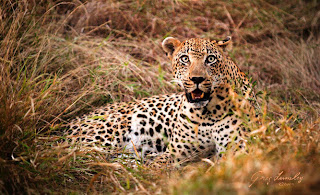While they may be smaller than the other members of the Panthera genus, the leopard are still extremely powerful cats. They have massive skulls with powerful jaw muscles. Head and body length ranges from 37 to 65 inches and shoulder height is from 18 to 31 inches. Females weigh between 51 and 130 pounds, while males are heftier at 66 to 200 pounds. The rather large 200 pound males have been spotted most frequently at Kruger National Park, which is good news for me because hopefully it meas they will be easier to see. As you probably noticed, the weight ranges are highly variable; males from South Africa's coastal mountains average about only 68 pounds. This variation is thought to result from the prey available to the leopard. The higher the quality and availability of the prey, the bigger the kitty.
 |
| What big teeth you have! |
Leopards are elusive, solitary, and usually nocturnal. The leopard's signature ability is its climbing ability. They like to sleep in the trees, eat in the trees, store their food in the trees, and jump down from the trees head first. Trees are a place of safety for their food and their young. There really isn't anything a a leopard won't take to a tree. For example, a leopard was seen hauling a young giraffe that was about 2-3 times its own weight. Water does not freak them out, and they are strong swimmers. They are agile and fast, able to reach a speed of 36 miles per hour. They can jump a good 6 feet horizontally and jump up to 3 feet vertically. Leopards use their powers to hunt anything from dung beetles to 2,000 pound giant elands. They eat a lot of ungulates and monkeys, but won't turn down rodents, reptiles, amphibians, insects, birds, fish, foxes, and jackals. A leopard has even been known to take down a sub-adult nile crocodile on land. All in all, leopards from Kruger National Park prey on at least 92 different species. Not many things prey upon the fully grown leopard, but lions, tigers, spotted hyenas and wild dogs have been known to prey on young leopards and even adult leopards.
Crossbreeding between leopards and other Panthera members has been documented. A leopon is the result of a cross between a lioness and a male leopard. Jagupars and Leguars result from crosses between leopards and jaguars. A pumapard results from a cross between a puma and a leopard. All pumapards inherit a form a dwarfism, growing to only half the size of their parents. They have a puma-like body, but short legs.
 |
| Pumapard |
 |
| Leopon |
 |
| Leguar |
Leopards can easily drive off cheetahs from kills because they are bigger and bulkier and stronger than them.





No comments:
Post a Comment